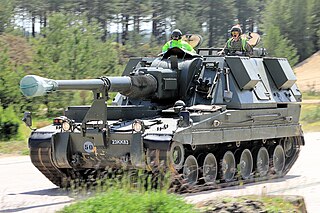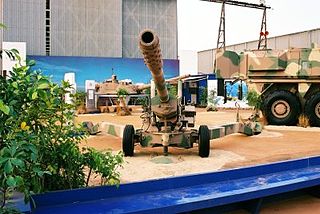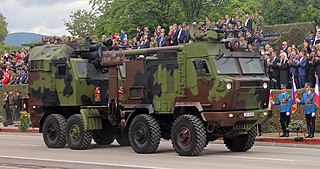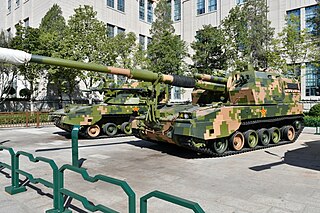
The AS-90, known officially as Gun Equipment 155 mm L131, is an armoured self-propelled artillery used by the British Army.

The GC-45 is a 155 mm howitzer designed by Gerald Bull's Space Research Corporation (SRC) in the 1970s. Versions were produced by a number of companies during the 1980s, notably in Austria and South Africa.

The G6, sometimes denoted as the G6 Rhino, is a South African mine-protected self-propelled howitzer. It was developed as a turreted, self-propelled variant of the G5 howitzer series, mating the gun to a six-wheeled armoured chassis. Design work on the G6 began in the late 1970s to replace the obsolescent Sexton being retired from service with the artillery regiments of the South African Army. Serial production commenced between 1988 and 1999.

The G7 is a South African 105 mm howitzer, produced by Denel Land Systems (DLS). With a maximum range of 32 km (20 mi) it outranges all existing 105 mm howitzers, as well as most current 155 mm howitzers. During development, it was known as the Light Experimental Ordnance (LEO), with the G7 label being chosen later to fit in with Denel's two existing howitzer products, the G5 towed 155 mm howitzer and the G6 self-propelled 155 mm howitzer.

Armscor, the Armaments Corporation of South Africa is the arms procurement agency of the South African Department of Defence. It was originally established in 1968 as an arms production company, primarily as a response to the international sanctions by the United Nations against South Africa due to apartheid which began in 1963 and were formalised in 1977.

The M777 howitzer is a British towed 155 mm artillery piece in the howitzer class. It is used by the ground forces of Australia, Canada, Colombia, India, Saudi Arabia, Ukraine, and the United States. It was first used in combat during the War in Afghanistan.
Space Research Corporation was a corporation founded by Gerald Bull, after the budget for his research at Project HARP for the United States and Canadian federal governments was cut in 1967, in order to commercialize the technology of long-range artillery. Project HARP's assets were then given to the newly formed SRC.

The South African Army Artillery Formation is the controlling entity of all South African Army artillery units. It draws much of its history from the South African Artillery, established in 1934 but with roots that reach back to 1921. The formation consists of both regular and reserve units. There is a separate South African Army Air Defence Artillery Formation that directs army anti-aircraft warfare units.

Denel Land Systems is a division of the Denel group.

The 130 mm towed field gun M-46 is a manually loaded, towed 130 mm artillery piece, manufactured in the Soviet Union in the 1950s. It was first observed by the west in 1954.

The Nora B-52 is a 155 mm self-propelled howitzer developed by Military Technical Institute and manufactured by Yugoimport SDPR in Velika Plana, Serbia.

The M-71 is a 155 mm 39 caliber towed howitzer manufactured by Israeli company Soltam Systems.

The PLZ-45 or Type 88 is a 155 mm self-propelled howitzer designed by Su Zhezi of 674 Factory, and developed by Norinco, 123 Factory, 127 Factory, 674 Factory and the Beijing Institute of Technology in the early 1990s for the export market. It is based on Norinco's Type 89 (PLL-01) 155 mm/45-calibre towed gun-howitzer.

The PLZ-05 or the Type 05 is a 155 mm self-propelled howitzer developed by the People's Liberation Army of China to replace the Type 59-1 130 mm towed gun and Type 83 152 mm self-propelled gun. The PLZ-05 was officially unveiled at the Military Museum of the Chinese People's Revolution to mark the 80th anniversary of the PLA in July 2007, and first entered service with the PLA in 2008.
The PLL-01, also known as the WAC-021, is a type of 155 mm howitzer designed by Gerald Bull and built by Chinese defense manufacturer Norinco.
105 mm is a common NATO-standard artillery and tank gun calibre. The rifled tank round is defined by STANAG 4458. The artillery round is defined by AOP-29 part 3 with reference to STANAG 4425.
The AH4 howitzer is a Chinese 155 mm towed howitzer system manufactured by Norinco. Its main characteristic is that it has been designed to be lightweight, which allows greater tactical mobility. The weight of 4,500 kg, compared to a traditional system that can weigh 18,000 kg, allows the system to be airlifted via heavy-lift helicopters like the CH-47 or Mi-26, or transport aircraft like a C-130 or Y-8. Also, as a modern howitzer system, it possesses a range of engagement of up to 40 km using rocket-assisted projectiles.
The South African defence industry is the most advanced in Africa and one of the most advanced and largest in the world with over 20 defence companies. The defence industry provides weapons and equipment to the South African National Defence Force (SANDF) and for export customers. The South African defence industry develops weapons and combat systems such as rifles, armored fighting vehicles, tanks, artillery, military aircraft, navy ships and missiles.















